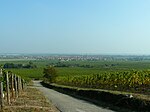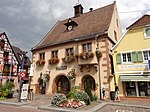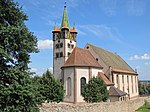Siege of Sélestat
1870 in FranceBattles involving BavariaBattles involving FranceBattles involving PrussiaBattles involving the Grand Duchy of Baden ... and 3 more
Conflicts in 1870October 1870 eventsSieges of the Franco-Prussian War
The siege of Sélestat was a siege, extending from 20 to 24 October 1870, of the French Alsatian fortress of Sélestat, during the Franco-Prussian War. After artillery bombardment by the Germans, the siege ended when the French army surrendered, mainly because the French garrison was demoralized. The Germans suffered only minor losses, while this victory brought them many spoils.
Excerpt from the Wikipedia article Siege of Sélestat (License: CC BY-SA 3.0, Authors).Siege of Sélestat
Place d'Armes, Sélestat-Erstein
Geographical coordinates (GPS) Address Nearby Places Show on map
Geographical coordinates (GPS)
| Latitude | Longitude |
|---|---|
| N 48.259444 ° | E 7.454167 ° |
Address
Place d'Armes 2
67600 Sélestat-Erstein
Grand Est, France
Open on Google Maps










